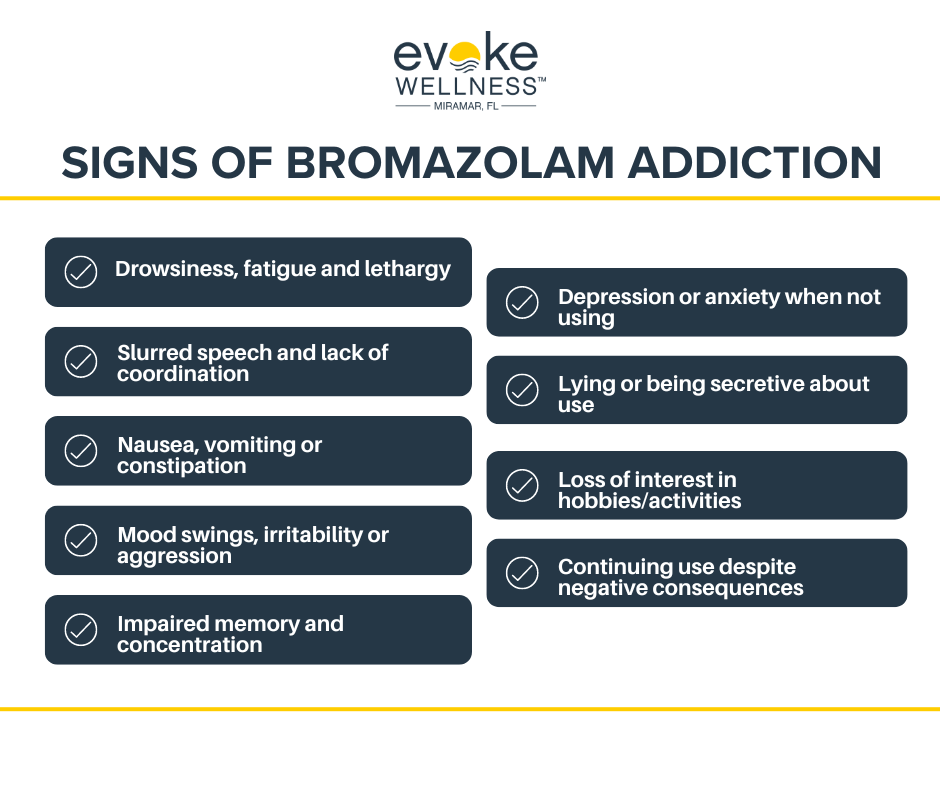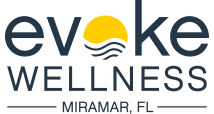Bromazolam is a potent designer benzodiazepine that has quickly gained popularity among substance users seeking anxiolytic and sedative effects. With a potency several times that of diazepam and a rapid onset of action, Bromazolam presents a high risk for abuse, addiction, and overdose. This article on the Evoke Wellness at Miramar blog will examine the effects, risks, and growing prevalence of Bromazolam use. It will also outline effective treatment options for those struggling with Bromazolam addiction. As this dangerous substance continues spreading across the US and globally, it is critical that medical professionals, treatment centers, and the public understand its dangers and how to address Bromazolam dependence in patients and loved ones.
What Is Bromazolam?
Bromazolam is a potent benzodiazepine drug developed in the 1970s. Originally researched as a treatment for insomnia, it has emerged as a recreational drug with high abuse potential.
Powerful Sedative Effects
With similar effects to other benzos like Xanax, Bromazolam produces intense sedation, muscle relaxation and amnesia at moderate doses. Its rapid onset and long half-life make it sought after by drug abusers.
Highly Addictive
Tolerance builds quickly with continued use, leading to dependence and severe withdrawal symptoms upon discontinuation. Cross-tolerance also occurs with other benzodiazepines and alcohol.
Effects and Dangers of Bromazolam Abuse
Physical Effects
Bromazolam abuse can lead to drowsiness, dizziness, confusion, and impaired coordination. Long-term use may cause physical dependence and withdrawal symptoms when trying to quit.
Mental Impact
This benzodiazepine has a high potential for psychological addiction and substance abuse. Chronic misuse can result in anxiety, depression, cognitive impairment, and psychosis.
Overdose Risks
Taking too much bromazolam, especially when combined with other depressants like alcohol or opioids, increases the likelihood of respiratory depression, coma, and fatal overdose.
The sedative effects of bromazolam make it dangerous to operate vehicles or machinery when under its influence. Abusing this potent tranquilizer puts users at serious risk of accidents, injuries and long-lasting health consequences.
Signs of Bromazolam Addiction
Physical Symptoms
- Drowsiness, fatigue and lethargy
- Slurred speech and lack of coordination
- Nausea, vomiting or constipation
Psychological Signs
- Mood swings, irritability or aggression
- Impaired memory and concentration
- Depression or anxiety when not using
Behavioral Indicators
Bromazolam addiction often manifests in behavioral changes like:
- Lying or being secretive about use
- Loss of interest in hobbies/activities
- Continuing use despite negative consequences
Early recognition of these signs is crucial for seeking timely addiction treatment and support services. Prolonged bromazolam abuse can have severe physical and mental health repercussions.

How to Get Treatment for Bromazolam Addiction
Seek Professional Help
The first and most crucial step is to seek help from qualified addiction professionals. Bromazolam addiction requires medical supervision during detox and withdrawal due to potentially severe symptoms.
Inpatient or Outpatient Programs
Inpatient rehab programs provide around-the-clock care and monitoring in a controlled environment, ideal for those with severe addictions. Outpatient programs allow more flexibility while receiving counseling and support.
Cognitive-Behavioral Therapy
Cognitive Behavioral Therapy (CBT) is an effective therapeutic approach that helps identify and change negative thought patterns and behaviors contributing to substance abuse. It equips individuals with coping strategies for triggers and cravings.
Support Groups
Joining a sober support group connects you with others on the recovery journey, providing encouragement, accountability and shared experiences. Popular options include SMART Recovery and Narcotics Anonymous.
Aftercare Planning
Ongoing aftercare support is vital for sustained sobriety. This may involve sober living housing, individual/group therapy, medication management and lifestyle changes to prevent relapse.
Addiction Treatment Program Options
Inpatient Rehab Programs
Inpatient or residential treatment programs provide intensive, around-the-clock care and supervision. Patients reside at the facility for the duration of treatment, typically 30-90 days. This immersive approach removes environmental triggers and promotes full healing.
Outpatient Programs
Outpatient programs allow more flexibility, enabling patients to live at home while attending regular therapy sessions. These vary in intensity from a few hours per week to multiple daily visits, depending on each person’s needs and progress.
Medication-Assisted Therapy
Certain medications can help manage cravings and withdrawal symptoms during detox and recovery. Combined with counseling and behavioral therapies, medication-assisted treatment improves outcomes for opioid, alcohol, and other substance addictions.
Aftercare & Alumni Support
Ongoing support through aftercare programs, peer groups, or alumni networks is crucial for relapse prevention. These services provide accountability, counseling, and community to maintain sobriety long-term after completing initial treatment.
Prescription Drug Addiction Treatment
Traditional Approaches
Prescription drug addiction is typically treated through a combination of medication, behavioral therapies, and support groups. Common medications include buprenorphine, methadone, or naltrexone to reduce cravings and withdrawal symptoms. Cognitive-behavioral therapy helps patients modify attitudes and behaviors related to drug use.
Holistic Healing
More holistic approaches focus on treating the whole person through therapies like mindfulness meditation, yoga, art therapy, and nutritional counseling. This mind-body approach aims to address underlying issues contributing to addiction while promoting overall wellness.
Specialized Programs
For severe addictions, inpatient or residential treatment programs provide around-the-clock support and intensive therapies in a substance-free environment. Outpatient programs offer more flexibility while still providing counseling, medication management, and peer support. The key is creating a personalized treatment plan addressing each individual’s unique needs.
Polysubstance Addiction Treatment
Polysubstance addiction involves abusing multiple substances simultaneously or in close succession. This compounded dependence heightens the complexity of treatment.
Integrated Approach
Effective polysubstance treatment requires an integrated approach targeting all substances concurrently. Cognitive behavioral therapy, contingency management, and medications like buprenorphine may be utilized.
Specialized Programs
Inpatient or residential programs specializing in polysubstance use disorders provide a controlled environment for comprehensive care. Intensive outpatient programs offering counseling and support groups are another option.
Ongoing Monitoring
Polysubstance recovery demands vigilant monitoring for cross-addiction and relapse prevention strategies. Peer support, lifestyle changes, and commitment to an aftercare plan promote lasting sobriety.
Dual Diagnosis Treatment
Comprehensive Care
Overcoming Bromazolam addiction often requires addressing co-occurring mental health disorders simultaneously. This “dual diagnosis” treatment provides comprehensive care for the interrelated issues. Integrated services allow for a coordinated therapeutic approach tailored to each individual’s needs.
Evidence-Based Therapies
Psychotherapy modalities like cognitive behavioral therapy (CBT) are proven effective for substance use and mental health conditions. CBT helps patients recognize patterns, reframe thoughts, and develop coping mechanisms. Medication may also be utilized to alleviate withdrawal symptoms or manage disorders like anxiety or depression.
Holistic Healing
Beyond clinical interventions, holistic therapies promote overall well-being during recovery. Mind-body practices like yoga, meditation, and mindfulness cultivate self-awareness and regulation skills. Nutritional counseling, exercise, and creative arts foster a multifaceted path to healing for dual diagnosis patients.
Medical Detox for Bromazolam Addiction
Medical detox is the first crucial step for individuals struggling with bromazolam addiction. This highly potent benzodiazepine requires careful tapering under medical supervision to avoid potentially life-threatening withdrawal symptoms.
Inpatient Detox Program
An inpatient detox program provides a safe, controlled environment monitored by medical professionals. Patients receive round-the-clock care and medication management to alleviate withdrawal symptoms and cravings.
Outpatient Detox Options
For milder cases, outpatient detox may be suitable. However, bromazolam’s potency often necessitates inpatient treatment for a successful, comfortable detox process. Comprehensive support and counseling address the psychological aspects of addiction.
Proper medical detox lays the foundation for long-term recovery by stabilizing the patient’s physical and mental state before further treatment.
FAQ: How to Choose the Right Bromazolam Addiction Treatment Center
Consider Accreditation & Licensing
Ensure the treatment facility is accredited by reputable organizations like the Joint Commission. Licensed professionals should staff the center providing evidence-based care.
Evaluate Treatment Approach
Look for centers offering a comprehensive, individualized approach combining medical detox, behavioral therapies, counseling, and aftercare planning. Bromazolam addiction often co-occurs with other substance abuse or mental health disorders requiring integrated treatment.
Review Success Rates
Research the center’s success metrics like program completion rates, relapse prevention strategies, and long-term recovery outcomes. Reputable facilities track data transparently.
Verify Insurance Coverage
Confirm your health insurance plan covers treatment costs at the facility, including any required pre-authorization or referrals. Understand out-of-pocket expenses.
Conclusion
Bromazolam addiction is a serious issue that should not be taken lightly. With its rapid onset and potent sedative effects, this research chemical poses a high risk for abuse and dependency. Education and harm reduction must remain priorities; understanding the risks allows people to make informed decisions. Support systems are invaluable for those struggling with addiction. There are many paths to recovery, but the journey begins with the choice to seek help. Society should respond with empathy and avoid stigmatization. Continued research into treatment options brings hope. By working together, real progress can be made against this threat to public health and safety.
Begin Your Journey with Evoke Wellness at Miramar
If you or a loved one is considering outpatient treatment, Evoke Wellness at Miramar invites you to contact us. Our compassionate team is ready to answer your questions, discuss your needs, and help you take the first steps toward recovery. In Miramar, you’ll find more than just a treatment program – you’ll discover a community dedicated to your wellness and success. Together, let’s embrace the journey to recovery and the promise of a new beginning. Call us at (833) 819-6066 today or reach out online.


